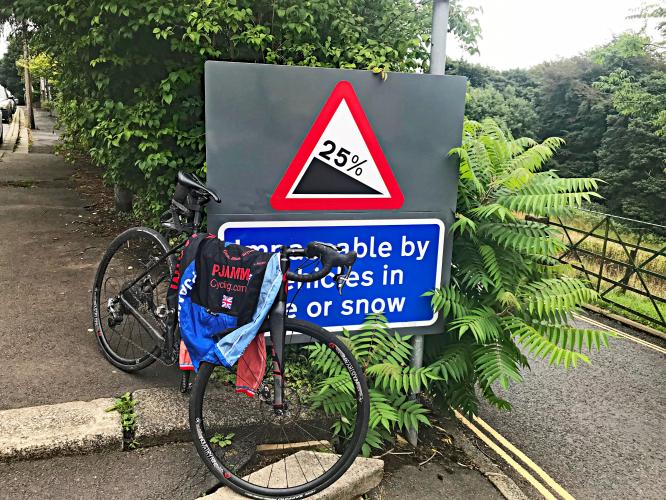![]()
Finish of The Rake (Chapel Lane)
Another short (900 m) but steep (10.5%) in Northern England. The Rake hosted the British National Hill Climb Championships in 1999 (Jim Henderson), 2005 (Ben Greenwood; Jim Henderson second by 0.3 seconds - denied his record tying 6th national championship) and 2012 (Jack Pullar).
![]()
Jake Pullard at 2012 Hill Climb Championship
Photo: Cyclingweekly.com
![]()
The climb begins at 10% for nearly 200 meters before tapering to 7% for a 100 meter respite. There is a 16.3% 100 meter section just before we complete a gradual left curve 550 meters from the start.
![]()
Start of the steepest section of the climb.
The road is in a residential area in good condition and with moderate slow moving traffic. There is the Church of Emmanuel Holcombe and an old cemetary near the top of the climb and an older community with attractive stone houses just beyond the finish.
![]()
Church of Emmanuel Holcombe near top of climb.
The climbs name “The Rake” seems to derive from the community of Rake in the middle of the climb along the steepest section of the climb (roads along and around this stretch include Rake, Rawsons Rake, and Rake Fold).
Simon Warren writes of this beast “A road so steep at the top it has a handrail fixed to the wall to assist pedestrians.”
Lancashirelife:
“Lancashire hosts one of Britain's shortest but most gruelling cycle races every October. It is a mere 947 yards from start to finish, but don’t be fooled by that. It has an average gradient of 1 in 8 and an awesome, lung-bursting, leg-breaking stretch of 1 in 4 near the top.
This is the road leading from the centre of Ramsbottom up to Holcombe Village and to describe the climb as severe would be an understatement. There is even a handrail on the steepest part to help panting pedestrians. This part is simply known as ‘The Rake’ and it’s a name to bring any cyclist out in a sweat.
It has always been a challenge. As long ago as 1929, when the Bury Cyclists’ Club was formed, members would try to see how far up they could ride before falling off. Eventually, as first one then another succeeded, it became a question of who could climb fastest and this developed into an annual time trial every October.” More
CyclingUphill.com:
“The Rake hill climb is a short and steep ‘classic’ British hill climb through the Lancashire town of Ramsbottom. It has featured in the Tour of Britain and has been the location for three national championships (1999, 2005, 2012) A wide variety of riders have attempted to ride the rake including Chris Boardman, Malcolm Elliott, Graeme Obree, Chris Newton and Michael Hutchinson.
The hill climb course is only 875 meters long. But, though short, it makes up for it in steepness – reaching a maximum gradient of 22%. (1 in 4.8).” More
This climb is in Ramsbottom (population 17,872):
“Ramsbottom is a market town in the Metropolitan Borough of Bury, Greater Manchester, England.[1] The population at the 2011 census was 17,872. Historically in Lancashire, it is on the River Irwell in the West Pennine Moors,3.9 miles (6.3 km) north-northwest of Bury, and 12 miles (19 km) north-northwest of Manchester.
Its name is believed to derive from Old English ramm and botm, meaning "valley of the ram". Its Victorian architecture, Pennine landscape and industrial heritage, including the East Lancashire Railway, contribute to heritage tourism in the town.
The name either means "ram's valley" from the Old English ramm, a ram and botm, a valley but could mean a wild-garlic-valley, with the first element representing the Old English hramsa meaning "wild garlic". A record from 1324 recording the name as'Ramesbothum is inconclusive. The town was alternatively recorded as Ramysbothom in 1540.
Evidence of prehistoric human activity has been discovered in the hills surrounding the town. Early records show that in Norman times Ramsbottom was part of the Forest of Rossendale. There are a number of Bronze Age burial sites around the town, the most notable of which is Whitelow Cairn, one mile (1.6 km) southeast of the town centre and three miles (4.8 km) north of Bury. The cairn was excavated by Bury Archaeological Group between 1960–62, under the leadership of Norman Tyson. Finds include one main and seven secondary cremations, four in urns, dating to the mid Bronze Age. Artefacts found during the excavation are housed in Bury Museum.
The early Anglo-Saxons who gave Ramsbottom its name progressively felled the woodland during the Middle Ages. Ramsbottom became an area of scattered woods, farmsteads, moorland and swamp with a small community of families until the late 18th century.” Wikipedia - Ramsbottom

 We've partnered with Sherpa-Map.com to bring you the best route planning tool. With a PRO Membership you can use this climb as a reference when creating your route.
We've partnered with Sherpa-Map.com to bring you the best route planning tool. With a PRO Membership you can use this climb as a reference when creating your route. 

